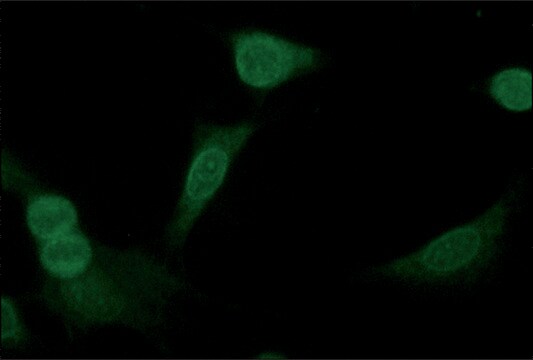MABN254
Anti-amyloid beta peptide (MOAB-2), pan Antibody, clone 6C3
clone 6C3, from mouse
Sinónimos:
Amyloid beta A4 protein, ABPP, APPI, APP, Alzheimer′s disease amyloid protein, cerebral vascular amyloid peptide, CVAP, PreA4, Protease nexin-II, PN-II
About This Item
Productos recomendados
biological source
mouse
Quality Level
antibody form
purified immunoglobulin
antibody product type
primary antibodies
clone
6C3, monoclonal
species reactivity
human
technique(s)
dot blot: suitable
immunofluorescence: suitable
immunohistochemistry: suitable (paraffin)
immunoprecipitation (IP): suitable
western blot: suitable
NCBI accession no.
UniProt accession no.
shipped in
wet ice
target post-translational modification
unmodified
Gene Information
human ... APP(351)
General description
Specificity
Immunogen
Application
Western Blot Analysis: A representative lot was used by an independent laboratory in unaggregated forms of Aß42 and Aß40. (Youmans, K.L., et al. (2012). Mol Neurodegener. 7;8.)
Dot Blot Analysis: Serial Aβ40 and Aβ42 dilutions were probed with MOAB-2 or 6E10 by an independent laboratory. (Youmans, K.L., et al. (2012). Mol Neurodegener. 7;8.)
Immunoprecipitationt Analysis: A representative lot was used by an independent laboratory in unaggregated and fibrillar forms of Aß42 and Aß40. (Youmans, K.L., et al. (2012). Mol Neurodegener. 7;8.)
Neuroscience
Neurodegenerative Diseases
Quality
Immunohistochemistry Analysis: A 1:1,000 dilution of this antibody detected Amyloid Beta Peptide in human Alzheimer′s diseased brain tissue.
Target description
Physical form
Storage and Stability
Analysis Note
Alzheimer′s diseased human brain tissue.
Other Notes
Disclaimer
¿No encuentra el producto adecuado?
Pruebe nuestro Herramienta de selección de productos.
Storage Class
12 - Non Combustible Liquids
wgk_germany
WGK 1
flash_point_f
Not applicable
flash_point_c
Not applicable
Certificados de análisis (COA)
Busque Certificados de análisis (COA) introduciendo el número de lote del producto. Los números de lote se encuentran en la etiqueta del producto después de las palabras «Lot» o «Batch»
¿Ya tiene este producto?
Encuentre la documentación para los productos que ha comprado recientemente en la Biblioteca de documentos.
Nuestro equipo de científicos tiene experiencia en todas las áreas de investigación: Ciencias de la vida, Ciencia de los materiales, Síntesis química, Cromatografía, Analítica y muchas otras.
Póngase en contacto con el Servicio técnico



